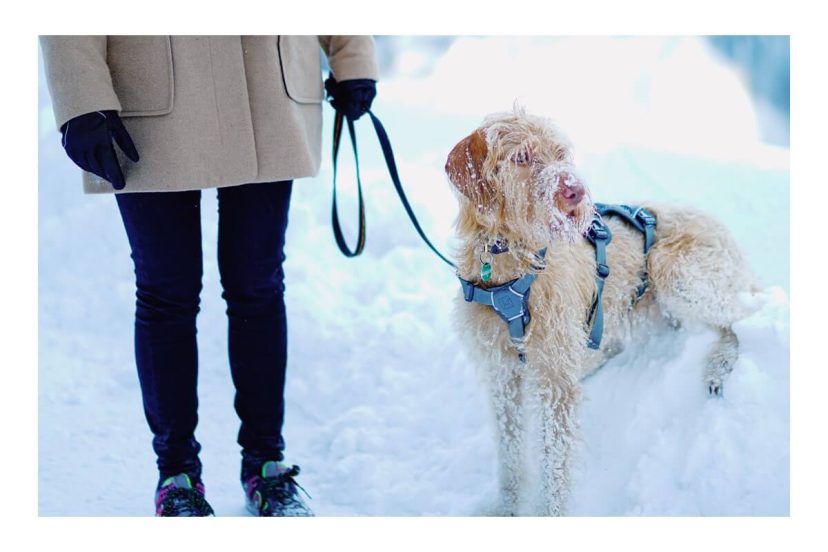Paws and Precautions: Mastering Winter Dog Walks Safely
Winter’s allure brings a frosty charm, but walking your dog in the cold presents unique challenges. Winter dog walks are all about overcoming icy sidewalks and chilly winds. This demands preparation and enthusiasm for an enjoyable winter adventure with your furry friend.
As a dedicated dog parent, nature’s call persists in snowy landscapes. Despite winter’s adversities, your pup’s daily walk remains essential for physical and mental well-being.
Explore our top 5 tips for navigating winter dog walks. From cold paws to warm precautions, embrace the season’s challenges for a joyful journey with your loyal companion.
Winter dog walks – let the adventure begin!
5 Cozy Canine Tips for Winter Dog Walks: A Dog Parent’s Guide
1. Navigating Weather & Winter Dog Walks
Deciding when it’s too cold for a dog walk requires gauging your own comfort— if the chilly weather chills you, it affects your furry friend too. Puppies, seniors, and those with specific health conditions demand extra caution in extreme temperatures, susceptible to frostbite and hypothermia.
While your dog’s fur coat offers some defense, winter can be harsh, especially based on their breed, age, and health. German Shepherds may handle the cold better than short-haired breeds like French Bulldogs or small dogs like Pugs. Older and smaller dogs struggle with temperature regulation, emphasizing the need for shorter, warmer walks. For optimal safety, avoid prolonged outdoor exposure in freezing temperatures. Consider factors like wind chill, precipitation, and sunlight when scheduling walks during the warmer late mornings or early afternoons.
2. Caring for Your Pup’s Paws in Winter
Cold winter dog walks pose challenges for sensitive dog paws. Trim the hair between their paw pads to prevent ice and salt buildup, ensuring a comfortable stroll. Post-walk, use a warm washcloth, paw wipes or dog paw balm to cleanse and soothe their paws, shielding them from the harsh effects of salt and de-icing chemicals.
Consider investing in dog boots, a practical solution to shield their paws from icy surfaces and damaging substances. Dog boots protect your doggie’s paws from harsh weather elements, salt, de-icing chemicals and anti-freeze that can dry out their paws and make your dog chill faster. The best way to make sure your dog’s winter walks are safe is using dog boots. If your pup resists booties, a wax-based cream can provide a protective layer. This cream not only safeguards against irritants but also aids in maintaining their overall body temperature during chilly walks.
Regularly check your dog’s paws for dryness or cracks, especially if they have long hair. Trim the hair around the paw pads to prevent painful ice balls and reduce the collection of salt and other damaging substances. Keep their nails trimmed, as long nails may increase susceptibility to irritants. After each walk, wash their paws, inspect for any signs of irritation, and apply a paw balm or petroleum jelly for moisturizing and protection. Always use moisturizing creams made specifically for dogs as human moisturizing creams can soften doggie paws making them susceptible to injury.
Pamper your pup’s paws with a Dog Paw Wax or Dog Paw Balm formulated with nourishing ingredients like vitamin E, shea butter, and coconut oil. These remedies offer a natural solution to combat dryness and fissures, ensuring your dog’s paws remain healthy and comfortable throughout the winter.
4. The Importance of Keeping Your Pup on a Leash
Resist the temptation to let your furry friend roam freely off leash, In the enchanting winter wonderland. Keep them securely leashed, using a leash and a collar light for added visibility during dark evenings. Snow drifts may conceal potential dangers, and unleashed dogs face risks of venturing onto frozen bodies of water. Stick to plowed sidewalks and carry a flashlight to navigate low-visibility situations. As daylight diminishes, invest in products like light-up collars and leads with reflective strips for increased visibility during walks. Leashing your dog in winter is crucial, preventing them from getting lost in heavy snowfall or reduced visibility. It safeguards them from potential hazards like unfrozen bodies of water, where surfaces may not be fully frozen or water levels might be higher from melted snow.
With dropping temperatures, secure leashing becomes a safety measure against freezing weather and aids in scent tracking in the snow. Whether during daylight hours with low visibility or at night, a leash ensures your dog stays by your side, reducing the risk of running onto icy patches or slippery roads. Always leash your dog when navigating ice-covered areas, as appearances can be deceiving, and the safety of both you and your pup is paramount.
5. Cozy Up: The Essentials of Winter Wear for Your Furry Friend!
As winter sets in, it’s not just humans who need to bundle up; our furry companions do too. Frostbite is a real concern, especially in exposed areas like ears, nose, footpads, and tail. Keep an eye out for signs and, if needed, warm up those extremities with gentle physical stimulation. Consider your dog’s breed and tolerance to the cold. While some, like Siberian Huskies, boast built-in insulation, others, especially smaller or thinner-coated breeds, may need extra warmth. A well-fitting dog coat or sweater is not just a fashion statement but a practical solution to keep your pup toasty during winter walks.
It’s not just about staying warm; it’s about being proactive. Young, old, or dogs with health issues require special attention. Watch for signs of discomfort even if your pup is bundled up. A water-resistant coat or sweater isn’t just an accessory; it’s a shield against the winter chill. Stay vigilant, stay warm, and make winter walks a comfortable adventure for your four-legged friend! Winter Wardrobe: Dressing Your Pup for Frosty Success! Winter dog walks can be harsh, and frostbite is a real concern for our furry friends. Paws, ears, and tails are especially vulnerable, so limit outdoor time and watch for signs. If your dog’s extremities seem too cold, warm them up with gentle physical stimulation.
Consider your dog’s breed and tolerance to cold. While some breeds naturally handle the chill, smaller or thinner-coated dogs may need extra warmth. A well-fitting dog coat or sweater, especially for young, elderly, or medically challenged pups, is not just a fashion statement but a practical solution to keep your pup toasty during winter walks. A water-resistant coat or sweater is a shield against the winter chill. Bundle up your furry companion in style and stay vigilant for any signs of discomfort. Even with a winter wardrobe, closely monitor your dog, especially in extreme conditions. Stay vigilant, stay warm, and make winter walks a comfortable adventure for your four-legged friend! Is Your Pup Feeling the Chill?
Recognizing Signs of Cold Discomfort!
Winter walks can be magical, but for our furry friends, it’s essential to watch for signs of discomfort. Shaking, whining, or a tucked tail are indicators that your dog might be feeling the cold. Even if they’re small, some dogs may lift or lick their paws, signaling discomfort.
Keep an eye out for changes in behavior—anxiety, reluctance to walk, or seeking shelter. Just like us, dogs have their limits in the cold. If it’s too cold for you, it’s likely too cold for them. In freezing temperatures, limit outdoor time, focusing on quick bathroom breaks, and compensate with indoor activities to keep them warm and entertained.
Signs that can indicate your dog is too cold:
- Shaking or shivering
- Hunched posture with a tucked tail
- Whining or barking
- Change in behavior, like seeming anxious or uncomfortable
- Slows down, reluctance to keep walking or tries to turn around
- Seeks places for shelter
- Holds paws up off the ground, licks paws
- Shallow breathing
Conclusion
Winter dog walks bring unique challenges, but with the right preparation, they can be joyful adventures. From navigating cold paws to ensuring cozy winter wear, keeping your dog on a leash, and recognizing signs of discomfort, your winter walks can be safe and delightful. As a devoted dog parent, prioritize your furry friend’s well-being during the frosty season, and let the winter wonders unfold in each step you take together.
FAQs:
Q1: How do I know if my dog is too cold during winter walks?
A: Watch for signs like shaking, whining, tucked tail, slowed pace, or seeking shelter.
Q2: Is it essential to use dog boots during winter walks?
A: Dog boots protect paws from harsh elements, salt, and chemicals, providing essential insulation.
Q3: Why should I keep my dog on a leash in winter?
A: Leashing ensures safety in reduced visibility, prevents separation, and guards against potential hazards.
Q4: What winter wear is suitable for my dog?
A: Consider your dog’s breed and tolerance; a well-fitting coat or sweater provides crucial warmth.
Q5: How can I pamper my dog’s paws after winter walks?
A: Use paw balm, wash their paws, and check for dryness or cracks to keep their paws healthy.




